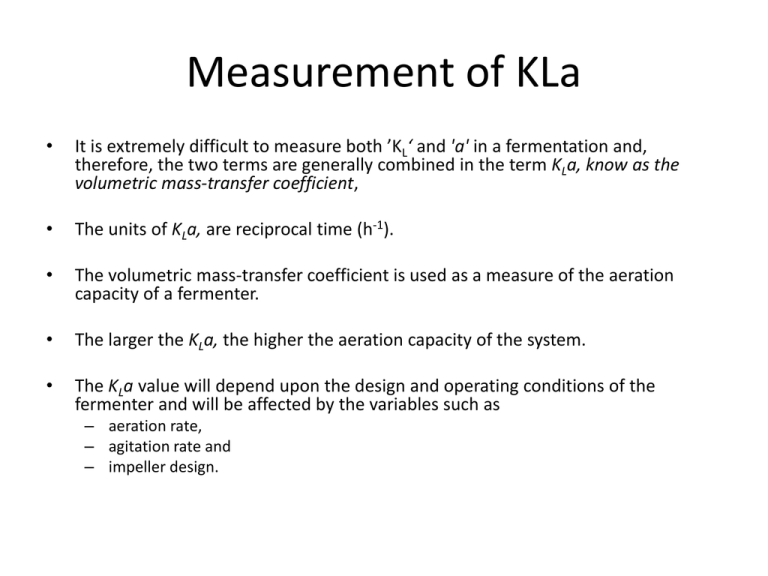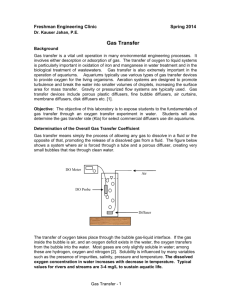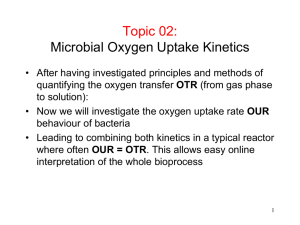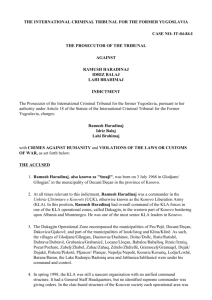File
advertisement

Measurement of KLa
•
It is extremely difficult to measure both ’KL‘ and 'a' in a fermentation and,
therefore, the two terms are generally combined in the term KLa, know as the
volumetric mass-transfer coefficient,
•
The units of KLa, are reciprocal time (h-1).
•
The volumetric mass-transfer coefficient is used as a measure of the aeration
capacity of a fermenter.
•
The larger the KLa, the higher the aeration capacity of the system.
•
The KLa value will depend upon the design and operating conditions of the
fermenter and will be affected by the variables such as
– aeration rate,
– agitation rate and
– impeller design.
• The determination of the KLa of a fermenter is
essential in order
– to establish its aeration efficiency and
– to quantify the effects of operating variables on
the provision of oxygen.
• The equations describing oxygen transfer are
based on dissolved oxygen concentration.
• The solubility of oxygen is affected by dissolved
solutes therefore pure water and a
fermentation medium saturated with oxygen
have different dissolved oxygen concentrations.
• Determination of KLa value is done by following
method:
– (i) Sulphite oxidation technique
– (ii) Gassing-out techniques
• Static gassing out method
• Dynamic gassing out method
– (iii) Oxygen-balance technique
(i) Sulphite oxidation technique
• The oxygen-transfer rates is determined by the
oxidation of sodium sulphite solution
• This technique does not require the measurement of
dissolved oxygen concentrations
• Based on the rate of conversion of a 0.5 M solution
of sodium sulphite to sodium sulphate in the
presence of a copper or cobalt catalyst:
Na2S03 + 0.502 = Na2S04
• As oxygen enters solution it is immediately consumed
in the oxidation of sulphite, so that the sulphite
oxidation rate is equivalent to the oxygen-transfer
rate.
• Since the dissolved oxygen concentration, is zero then
the KLa may then be calculated from the equation:
dCL / dt = OTR= KLa . C*
(i)
KLa = OTR/ C*
where OTR is the oxygen transfer rate
• The volumes of the thiosulphate titrations are
plotted against sample time and the oxygen
transfer rate may be calculated from the slope
of the graph.
(ii) Gassing-out techniques
• The estimation of the KLa of a fermentation system by
gassing-out techniques depends upon monitoring the
increase in dissolved oxygen concentration of a solution
during aeration and agitation.
• The oxygen transfer rate will decrease during the period of
aeration as CL approaches C* due to the decline in the driving
force (C* - CL ).
• The oxygen transfer rate, at particular time, will be equal to
the slope of the tangent to the curve of values of dissolved
oxygen concentration against time of aeration, as shown in
Fig.
Fig. The increase in dissolved oxygen concentration of a solution over a period of aeration.
The oxygen transfer rate at time X is equal to the slope of the tangent at point Y.
• To monitor the increase in dissolved oxygen
over an adequate range it is necessary first to
decrease the oxygen level to a low value.
• Two methods have been employed to achieve
this lowering of the dissolved oxygen
concentration –
– the static method and
– the dynamic method.
Static gassing out method
First described by Wise (1951),
The oxygen concentration of the solution is lowered by gassing the
liquid out with nitrogen gas, so that the
solution is 'scrubbed' free of oxygen.
The deoxygenated liquid is then aerated and agitated and the
increase in dissolved oxygen monitored using some form of
dissolved oxygen probe.
The increase in dissolved oxygen concentration is given by –
dCL / dt = KLa(C*-CL)
(ii)
Taking logarithm after Integration of equation (ii) we have
ln(C*-CL) = - KLa.t
A plot of the In(C* - CL) against time of aeration, the
slope of which equals -KLa.
Dynamic gassing out method
OTR = dCL / dt = KLa(C*-CL) – xQO2
--------(iii)
Where,
• x is the concentration of biomass and
• QO2 is the specific respiration rate (mmoles of
oxygen g-l biomass h- I).
• The term xQO2 is given by the slope of the
line AB in Fig -1.
Fig.1. Dynamic gassing out for the determination of KLa values.
Aeration was terminated at point A and recommenced at
point B.
• Equation (iii) may be rearranged as:
CL = -1/KLa{(dCL / dt)+ xQO2}+C*
----------------(iv)
• Now from equation (iv), a plot of CL versus dCL/dt +
xQO2 will yield a straight line, the slope of which will
equal -1/KLa, as shown in Fig. 2.
Fig. 2 . The dynamic method for determination of KLa values. The
information is gleaned from Fig. 9.7. by taking tangents of the
curve, Be, at various values of CL'
Fig. 3.
The occurrence of oxygen limitation during the dynamic
gassing out of a fermentation.
Advantages
• The dynamic gassing-out method has the
advantage over the previous methods of
determining the KLa during an actual
fermentation and may be used to determine K L a
values at different stages in the process.
• The technique is also rapid and only requires the
use of a dissolved-oxygen probe, of the
membrane type.
Limitations
• A major limitation in the operation of the technique
is the range over which the increase in dissolved
oxygen concentration may be measured.
• It may be difficult to apply the technique during a
fermentation which has an oxygen demand close to
the supply capacity of the fermenter.
• Both the dynamic and static methods are also
unsuitable for measuring KLa values in viscous
systems.
(iii) Oxygen-balance technique
• Use to measure KLa during fermentation
process.
• The amount of oxygen transferred is
determined, directly into solution in a set time
interval.
• The procedure involves measuring the
folIowing parameters:
The procedure involves measuring the folIowing
parameters:
(i) The volume of the broth contained in the vessel,VL (dm3).
(ij) The volumetric air flow rates measured at the air inlet
and
outlet, Qi and Qo' respectively (dm3 min~ 1).
(iii) The total pressure measured at the fermenter air inlet
and
outlet, Pi and Po, respectively (atm. absolute).
(iv) The temperature of the gases at the inlet and outlet, 1;
and
To, respectively (K).
(v) The mole fraction of oxygen measured at the inlet and
outlet, Yi and Yo' respectively.
• The oxygen transfer rate may then be determined from
the folIowing equation (Wang et al., 1979):
OTR = (7.32 X 1Q5/VL )(QiPiyi/Ti - QoPoyo/To)
--------------(v)
• Where 7.32 X 105 is the conversion factor equalIing
(60min h ~l) [mole/22.4 dm3 (STP)] (273 K/l atm).
• These measurements require accurate flow meters,
pressure gauges and temperature-sensing devices as
welI as gaseous oxygen analysers.
• The ideal gaseous oxygen analyser is a mass
spectrometer analyser which is sufficiently accurate to
detect changes of 1 to 2%.
• The KLa may be determined, provided that CL
and C* are known, from equation(1) :
dCL / dt = KLa(C*-CL)
Or
OTR =KLa (C*-CL)
Or
KLa = OTR/(C*-CL)
• The oxygen-balance technique appears to be
the simplest method for the assessment of
KLa and
• Has the advantage of measuring aeration
efficiency during a fermentation.
FACTORS AFFECTING KLa VALUES IN
FERMENTATION VESSELS
• A number of factors have been demonstrated to affect
the KLa value. Such factors include
– the air-flow rate employed in vessels,
– the degree of agitation inside vessels ,
– the rheological properties of the culture broth and
– the presence of antifoam agents.











